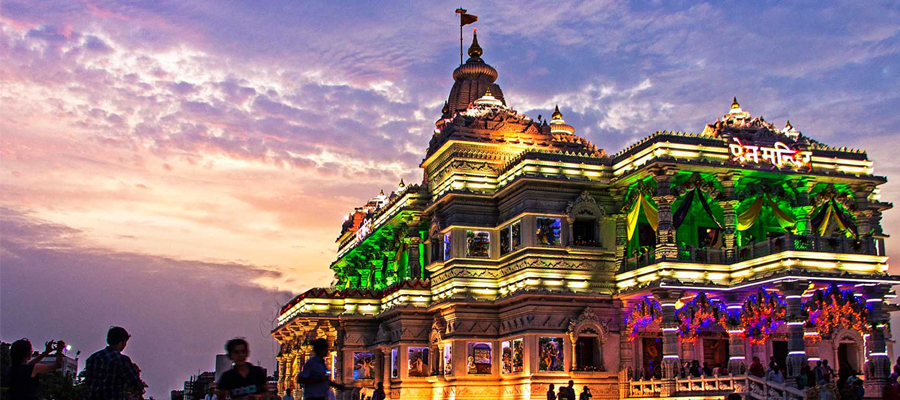
Overview
Pivotal significance has been attached to Mathura in the Hindu theology. Not only is it counted one among the seven sacred cities, Mathura is also deemed devout being the birthplace of Lord Krishna - the epitome of love and divine ecstasy!
Barely 10 km away from Mathura lays Vrindavan, where practically every nook and corner has charming Lord Krishna stories to tell.
Introducing Mathura
Mathura and twin city Vrindavan are prominent pilgrimage centers of Hindus. In fact, since Mathura to Agra distance is barely 50 km and Vrindavan from Mathura is not more than 10 km away - Agra-Mathura-Vrindavan tour is a norm in most travel itineraries.
Heritage Places / Sightseeing in Mathura
- Dwarkadheesh Temple, Mathura
In the heart of the old Mathura city, near the eastern bank of the Yamuna River, stands tall the most frequently visited Dwarkadheesh Temple. Existing since 1814, the temple witnesses fervent celebrations of all the Hindu festivals including Janmashtami (Birthday of Lord Krishna), Mathura Holi and Diwali, with élan. The temple exudes spellbinding grandeur in August during the 13-days celebrations of the local Jhulan Yatra festival (or the swing festival).
- Vishram Ghat, Mathura
The shopping area around the Dwarkadheesh Temple has narrow lanes that pour out to the Yamuna riverfront dotted with 25 Ghats and a string of elegant temples. At the northern side of the riverfront lays the central and the most important Vishram Ghat. It is believed that Lord Krishna rested here after exterminating His tyrannical and malevolent uncle, demon King Kansa. The traditional “parikrama” (circumambulation) of Mathura’s religious and cultural spots also starts and ends here. The daily aarti (prayer with lit lamps) of the Yamuna River also takes place at this ghat every evening. Both devotees and tourists in equal measure begin pouring in at the ghat with the onset of dusk to collectively sing, chant, clap and wave lit lamps before the river in prayers. To be a part of the energy field created hence is truly an outstanding experience. Not to mention, to witness hundreds of small lit lamps floating together on the river surface and their tiny lights getting reflected in the shimmering river water is a divine spectacle in itself.
- Krishna Janmabhoomi Temple / Kesava Deo Temple
Of all the popular Mathura tourist places, the main Mathura temple is the Krishna Janmabhoomi Temple, also known as the Kesava Deo Temple. The complex is believed to house the small prison cell where Lord Krishna was born to Vasudev and Devaki. Numerous excavations undertaken on the site in the past years have also yielded affirmative testimonies that the complex stands on the same site as the birthplace of Lord Krishna. The artifacts recovered from the excavations are on display in a museum in the vicinity. Potra Kund is another place of tourist interest close by, which is a historical pond presently being preserved by the archaeological survey of India. It is believed that the pond was earlier a part of the prison where parents of Lord Krishna -Vasudev and Devaki – used to wash clothes of their newborns.
- Gita Mandir/ Birla Mandir
Just 5 km from Mathura en route to Vrindavan lays Gita Mandir, also known as Birla Mandir (being built by renowned Birla family). Built in 1946, it is one of the modern Hindu temples famous for “Gita Stambbh” (Gita Pillar) that is inscribed with excerpts from the supremely venerated “Bhagwad Gita” (Holy Scripture of Hindus).
- Krishna Balaram Temple/ ISKCON Temple, Vrindavan
To begin with, Krishna Balaram temple - the ISKCON temple near Mathura - is possibly the most sought after seat of the International Society for Krishna Consciousness in India. The white marble temple is gracefully sitting at Raman Reti in Vrindavan since 1975 and continues to draw tourists in large numbers from all over the world for paying obeisance, as well as, to attend seminars and courses here every year.
- Rangaji Temple, Vrindavan
Rangaji Temple in Vrindavan is a unique South Indian Dravidian styled temple dating back to 1851. The temple is the largest in entire Vrindavan and is chiefly devoted to Lord Vishnu and His consort Goddess Lakshmi. The temple witnesses particular gaiety and jubilation during the ten-day chariot festival that takes place here between March-April, every year.
- The Bankey Bihari Temple, Vrindavan
is globally reckoned to be the holiest and the most popular temples of Lord Krishna, where He is worshipped as a child. The hypnotic black idol installed in the temple is believed to be a mystical unity of Lord Krishna and His consort Radhaji, granted to Swami Haridas by the celestial couple themselves. The temple neither has conches/ bells within the complex nor is the tradition of early morning prayers observed here. The underlying intention is to keep the temple the most pleasant and the least disturbing for the seating deity who is treated like a child here by all His devotees.
- Nidhi Van and Seva Kunj, Vrindavan
Nidhi Van (Nidhi forest) is inarguably the most popular and frequented temple in Vrindavan, sometimes also called as Madhu Van and Tulsi Van. In the middle of the forest of small-sized trees lays Sewa Kunj, also known as Nikunj Van, which is a temple sacred to Lord Krishna and His consort Radhaji. Another temple inside is called Nij Mandir (own temple) that is painstakingly decorated with flowers and appointed with holy water, sweets and ingenious toothbrushes every evening after prayers. In the morning, the entire arrangements are found disarrayed as if used/ consumed. It is also believed that no moving life form, be it animal or human, can stay back at the Nidhi Van at night or thou shall be found insane/ dumb-deaf/ lame, blind, or even dead. It is also believed that Lord Krishna along with consort Radha ji appears here at night and performs entrancing “Ras Lila” (playful spiritual activities). So, anyone who accidentally stays back in the temple is rendered unfit to disclose the spiritual secret of the Lord and his consort.
- The oldest of Vrindavan temples
Legend also has it that about five thousand years ago, Vajranabha (the grandson of Lord Krishna) installed several deities around Vrindavan to mark all the important places where Lord Krishna spent his childhood. In the 16th century, Lord Chaitanya Mahaprabhu incarnated and located these lost sacred spots. He ordered his close associate Srila Sanatana Goswami to excavate the sites and re-install the deities. As a result, the deities inside the Madan Mohan temple (near the Kali Ghat) and the Govind Dev temple were discovered.
Later in time when Akbar visited Vrindavan in 1570, he sanctioned construction of four temples in Vrindavan, including Madan Mohan temple – being the oldest, followed by Govind Dev Temple (1590), Jugal Kishore Temple (1627) and Shri Gopinath Temple (1632). However, during the tyrannical rule of Mughal emperor Aurangzeb, three of these temples were vandalized and rendered unholy for worship. The original idols of the deities were shifted to Jaipur (Rajasthan) for safe-keeping and accurate replicas were installed at the freshly appointed sanctum sanctorum about the temple complexes. The Govind Dev temple was not only defaced, but also reduced to two-stories, as against its original seven-story form. The Jugal Kishore temple somehow managed to remain unscathed – to this day surviving in the original structure with the original deity.
- The list of temples in Vrindavan cannot be complete without mention of Prem Mandir (Love temple), which is a rather new entry made up of Italian marble and has doors that open in all directions. The magnificent 122 feet (length) by 115 feet (width) by 125 feet (high) temple is well-appointed with fountains and gardens on all four sides and indeed a stunning instance of amalgam of ancient and modern architectures.
- Radha Ramana temple
- Radha-Damodara temple
- Radha Gokulananda temple
- Radha Vallabha temple
- Gopesvara Mahadeva temple
- Jaipur temple
- Shahji temple
- Imlitala temple
- Garud Govind temple
- Goverdhan near Mathura is famous for 21 km long circumambulation around the holy Goverdhan hill.
- 15 km South East of Mathura sits Gokul where Lord Krishna spent his tender childhood. The famous places to visit here include Ramanreti, Gokulnath temple and Shri Thakurani Ghat.
- Nandgaon is located 51 km from Mathura, popular for being the home to the foster father of Lord Krishna. The famous temples in Nandgaon include Nanda Bhavan (or Nandagram Temple) and adjoining Lord Shiva's Nandisvara Temple. The seating deities in both the temples have been reportedly installed by Lord Krishna's grandson Vajranabha about 5000 years ago. Pavana Sarovar (Purifying pond) at Nandagoan is reportedly the same lake where Mother Yashoda used to give bath to Lord Krishna as a child and later on Lord Krishna would bathe His cows after their returning from grazing. Charan Pahari here is believed to have the foot imprint of Lord Krishna on a venerable rock.
- Barsana is situated 21 km North of Goverdhan, which is believed to be the birthplace of Lord Krishna's consort Radhaji. The deity of Ladli Lal or Lali Ji (local name of Radha Ji here) in the famous Shriji temple here was also installed by Vajranabh 5000 years ago.
Places around Mathura and Vrindavan worthy of a visit
Pilgrims and tourists who visit Mathura and/or Vrindavan also like to visit a few surrounding areas closely associated with Lord Krishna for one reason or the other.
How to reach Mathura
By AirThe nearest airport to Mathura is at Kheria in Agra, barely 57 km away. Nearest international airport to Mathura is IGI Airport in New Delhi about 155 km in distance.
By RailMathura Railway Junction in Mathura joins the city to all the major cities across Indian margins.
By RoadA well-knit network of highways connects Mathura to all the major Indian cities inside and outside Uttar Pradesh. Both State Transport and privately owned vehicles ply to transport tourists to and fro Mathura from destinations like Delhi, Agra and Vrindavan among other major cities in India.
Best season to visit Mathura and Vrindavan
Akin to Delhi, weather in Mathura and Vrindavan is hostile during summers (April to June) followed by wet and humid monsoon season (July to September). The temperature during the winter season (October to March) oscillates between 31 and 2 degree Celsius, which is comparatively pleasant than the other seasons. Though the cities remain ever drenched in the devotion to Lord Krishna, yet weather-wise it is suggested to visit Mathura/ Vrindavan during the winter season.
Not to mention, the feel and aura of Mathura and Vrindavan are especially enthralling during the festivals sacred to Lord Krishna/ Radha Rani ji. To be a part of one of the ongoing celebrations - be it Krishna Janmashtami (August-September), Radhaashtami (September) or Holi (March) or Guru Poornima (July-August) – is a once in a lifetime experience when one can’t help but falls in love with the environs, the devotees, and of course, the seating deities.

